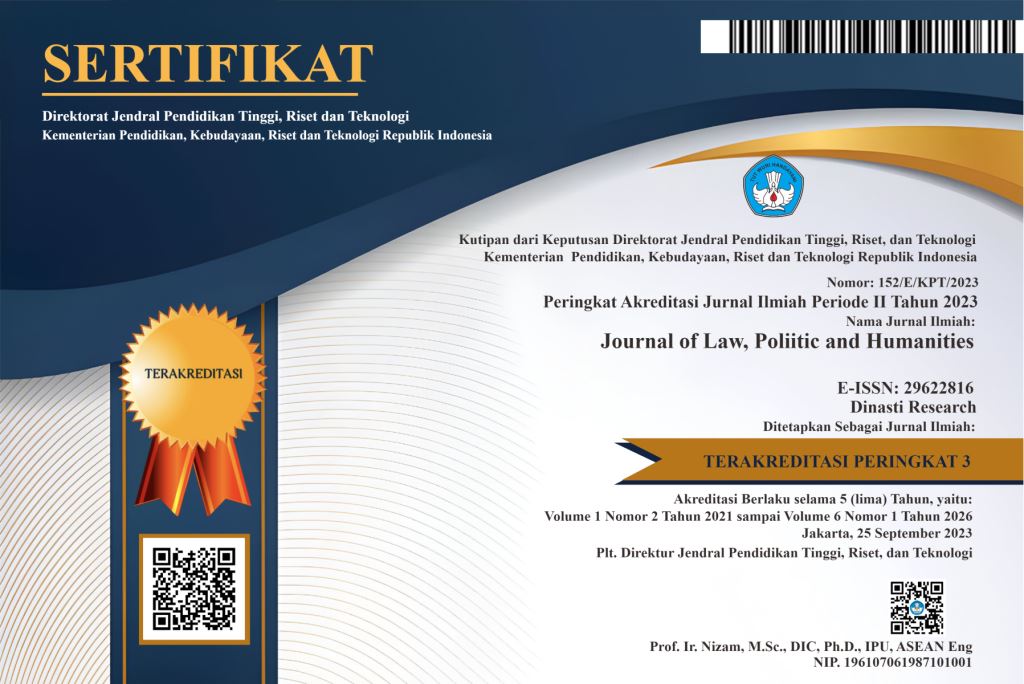Analysis of the Role of Socialization of Bpjs Program: A Study on Employee Nonparticipation in the Socialization Process
DOI:
https://doi.org/10.38035/jlph.v5i5.1871Keywords:
BPJS, Non-Participation, Employee, Role, SocializationAbstract
Socialization of the BPJS program is a strategic effort to increase understanding and participation of workers in the social security system. However, in practice, there are still employees who do not follow the socialization process, thus potentially hampering the effectiveness of the program. This study aims to analyze the role of the Social Security Organizing Agency (BPJS) in socializing the health insurance program for workers and to identify factors that cause workers' non-engagement. This research uses a qualitative approach with interview techniques, observation, and documentation analysis of employees and socialization organizers. The results showed that the role of BPJS in socializing the health insurance program has not been fully effective. The effectiveness of socialization depends on the communication strategy used, the level of involvement of company management, and the method of delivering information. Employee disengagement is caused by lack of access to effective information, lack of support from the company, and the perception that socialization does not have significant added value. Therefore, a more interactive, adaptive, and technology-based communication strategy is needed to increase employee involvement in the socialization of the BPJS program.
References
Aseandi, R. (2024). Socialization of BPJS Employment Benefits for Independent Workers in Improving Work Safety in the Pekan Sawah Community, Sei Bingai District, Langkat Regency. Community Deaplopment Journal, 5(1).
Handoyono, S. (2018). Legal Effectiveness of Company Compliance in BPJS Health Participation. De Fasto Journal, 5(1).
Keban. (2014). Six Strategic Dimensions of Public Administration, Concepts, Theories and Issues. Gavamedia.
Khiro, A. (2015). Effectiveness of Socialization of the Health Insurance Program on the Knowledge and Attitudes of Non PBI Agricultural Business Households in Jember Regency in 2015. Ikesma Journal, 11(1).
Komariah. (2014). Qualitative Research Methodology. Alfabeta.
Kurniawati. (2020). The Role of Communication in Increasing Community Involvement in the Social Security Program. Journal of Communication Science, 5(2).
Melinda. (2016). Factors Associated with Community Interest in Independent BPJS Participation in Bener District, Purworejo Regency. JKM: Journal of Public Health, 4(4).
Mulyadi. (2015). Public Policy and Public Service Studies. Alfabeta.
Murtini, & Agustin. (2019). The Importance of Effective Communication in Public Services. Journal of Public Administration, 10(1).
Ories, M. (2023). Socialization of the Employment Social Security Agency for the People of Ploso Village, Krembung Subdistrict, Sidoarjo Regency. PADI: Journal of Indonesian Lecturer Community Service, 6(1).
RI, P. P. (2004). Law Number 40 of 2004 on Social Security System (State Gazette of the Republic of Indonesia Year 2004 Number 150).
RI, P. P. (2011). Law Number 24 Year 2011 on Social Security Provider Agency (State Gazette of the Republic of Indonesia Year 2011 Number 216).
Solechan. (2019). Health Insurance Provider Agency as a Public Servant. Administrative Law and Goverment, vol.2(4).
Tahir (2014). Public Policy and Transparency of Local Government Implementation. Alfabeta.
Widodo. (2018). Public Policy Analysis (Concepts and Applications of Public Policy Process Analysis). Media Nusantara Kreatif.
Winarno. (2012). Public Policy (Process Theory and Case Studies. CAPS.
Downloads
Published
How to Cite
Issue
Section
License
Copyright (c) 2025 Alvian Akbar, Yuanita, Happy Yulia Anggraeni

This work is licensed under a Creative Commons Attribution 4.0 International License.
Authors who publish their manuscripts in this journal agree to the following conditions:
- The copyright on each article belongs to the author(s).
- The author acknowledges that the Journal of Law, Poliitic and Humanities (JLPH) has the right to be the first to publish with a Creative Commons Attribution 4.0 International license (Attribution 4.0 International (CC BY 4.0).
- Authors can submit articles separately, arrange for the non-exclusive distribution of manuscripts that have been published in this journal into other versions (e.g., sent to the author's institutional repository, publication into books, etc.), by acknowledging that the manuscript has been published for the first time in the Journal of Law, Poliitic and Humanities (JLPH).


























